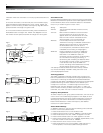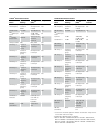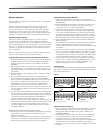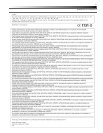
3000 Series Installation and Operation
3
is detected, reducing the possibility of interference. As a result, 3000
Series transmitters and receivers must be used together and should
not be used with components from other Audio-Technica wireless
systems, or with those of other manufacturers. Exception: 3000 Series
components are compatible with Audio-Technica 1800 Series wireless
system components.
Please note that in multiple-system applications there must be a
transmitter-receiver combination set to a separate frequency for each
input desired (only one transmitter for each receiver). Because the
wireless frequencies are within UHF TV frequency bands, only certain
operating frequencies may be useable in a particular geographic area.
Receiver Installation
Location
For best operation the receiver should be at least 3 ft. (1 m) above the
ground and at least 3 ft. away from a wall or metal surface to minimize
reections. The transmitter should be at least 3 ft. from the receiver,
as shown in Figure A. Keep antennas away from noise sources such
as digital equipment, motors, automobiles and neon lights, as well as
away from large metal objects.
Fig. A
Output Connections
There are two audio outputs on the back panel: balanced and
unbalanced. Use shielded audio cable for the connection between the
receiver and the mixer. If the input of the mixer is a
1
/
4
" jack, connect a
cable from the
1
/
4
" unbalanced audio output on the back of the receiver
housing to the mixer. If the input of the mixer is an XLR-type input,
connect a cable from the balanced XLR-type audio output on the back
panel to the mixer. The two isolated audio outputs permit simultaneous
feeds to both unbalanced and balanced inputs. For example, both a
guitar amp and a mixer can be driven by the receiver.
Antennas
Attach the included pair of UHF antennas to the antenna input jacks.
The antennas are normally positioned in the shape of a “V” (both 45°
from vertical) for best reception.
Antennas can be remotely located from the receiver. However, due
to signal loss in cables at UHF frequencies, use the lowest-loss RF
cables practical for any cable runs over 8 m/25 feet. RG8-type is a good
choice. Use only copper-shielded cable, not CATV-type foil-shielded
wire. Audio-Technica offers quality RF cables in four lengths, as well as
remote antennas.
Either passive or active antennas may be used. Both input jacks
offer switchable +12 V DC output on their center pins to operate
Audio-Technica powered antennas or other in-line RF devices if desired.
Up to 60 mA can be drawn from each antenna input jack.
Power Connections
Connect the included AC adapter to the DC power input on the back of
the receiver. Loop the small cord from the DC plug over the cord hook
above the jack, to keep the plug from being detached by an accidental
tug on the cord. Then plug the AC adapter into an AC power outlet.
Operation of the receiver is controlled by the front-panel Power switch.
Receiver Controls and Functions
Front Panel Controls and Functions
Fig. B
1. POWER SWITCH: Press Power switch in and the receiver
readouts will light.
2. ALERT INDICATOR: The Alert Indicator lights:
(a) When the receiver is in the Function Edit mode,
(b) When no RF signal is received from transmitter,
(c) When only one or two RF signal-strength bars are on,
(d) When the transmitter is in the Mute mode,
(e) When audio modulation level from the transmitter is close to the
clipping point (AF +3/+6 bars),
(f) When only one bar of the Battery “fuel gauge” is on (transmitter
battery is weak).
3. LCD WINDOW: Backlit screen indicates control settings and
operational readings. See Figure D for examples.
4. TUNER OPERATION INDICATOR: Indicates which Tuner (A or B) has
the better reception and is in operation. The “B” indicator also lights
to serve as conrmation of Mode/Set button entries.
5. UP/DOWN BUTTONS: Press Up or Down arrow buttons, in
conjunction with the Mode/Set button, to step through menus,
select operating frequency and edit receiver function choices.
6. MODE/SET BUTTON: Use in conjunction with the Up/Down arrow
buttons to step through menus, choose operating frequency, initiate
automatic scanning and select receiver function options.
7. MOUNTING ADAPTERS: For mounting the receiver in any standard
19" rack. Attach adapters to the receiver with the screws supplied
and remove the four receiver feet. (Use optional AT8630 joining-
plate kit to mount two ATW-R3100b receivers side-by-side.)
Rear Panel Controls and Functions
Fig. C
8. ANTENNA INPUT JACK: BNC-type antenna connector for Tuner “B.”
Attach the antenna directly, or extend it with a low-loss antenna
cable.
9. ANTENNA INPUT JACK: Input for Tuner “A.” Attach the antenna
directly, or extend it with a low-loss antenna cable.
10. AF LEVEL CONTROL: Adjusts audio output level of both AF Output
jacks; maximum output is fully clockwise.
11. GROUND LIFT SWITCH: Disconnects the ground pin of the
balanced output jack (12) from ground. Normally, the switch should
POWER
MODE/SET
UHF SYNTHESIZED DIVERSITY RECEIVER ATW-R3100b
ALERT
-TUNER-
A
B
ON
OFF
AF OUT
UNBALANCED
AF OUT
BALANCED
ANT. A
ANT. B
AF
LEVEL
GROUND LIFT
12~18V
DC500 mA
GROUND
POWER
MODE/SET
UHF SYNTHESIZED DIVERSITY RECEIVER ATW-R3100b
ALERT
-TUNER-
A
B
ON
OFF
1 2 3 4 5 6
8 9 10
11 13 14
1512
7


















